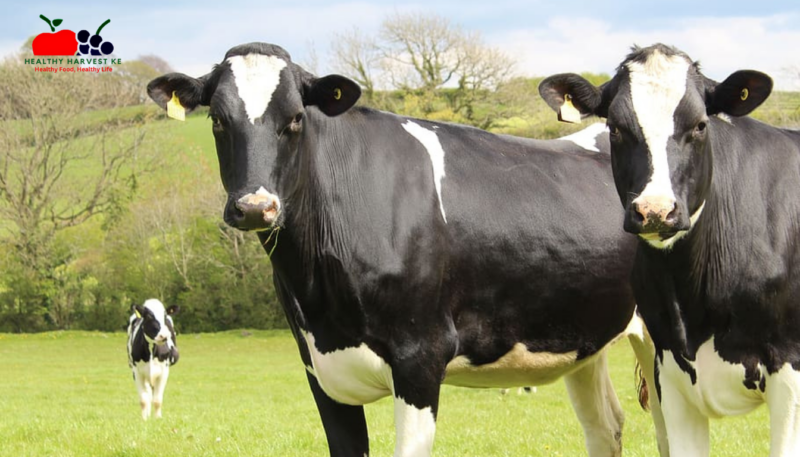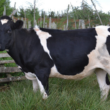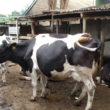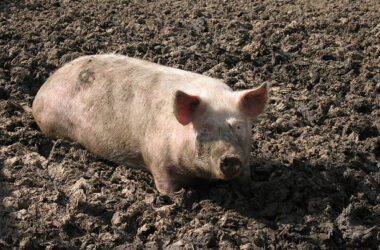Why Dairy Farming in Kenya?
Looking to dive into the world of dairy farming in Kenya? Smart move. Kenya’s dairy industry isn’t just thriving—it’s the second-largest in Africa by herd size and makes up a solid 14% of the country’s agricultural GDP. This isn’t your average side hustle; it’s a legitimate pathway to sustainable income in one of East Africa’s most established agricultural sectors.
But let’s keep it real—dairy farming isn’t all green pastures and easy money. The industry faces its fair share of challenges, from feed costs that’ll make your wallet weep to climate change throwing curveballs at your business plan. That said, with the right approach and some smart moves, you can still carve out your piece of this lucrative market.
This guide breaks down everything you need to know to start your dairy farming journey in Kenya—from picking the right location to marketing your milk. We’re not here to sugarcoat anything. Dairy farming requires commitment, knowledge, and some serious elbow grease. But if you’re ready to put in the work, let’s get your dairy dream off the ground.
Step 1: Understanding Kenya’s Dairy Landscape
Before you buy your first cow, get familiar with how Kenya’s dairy sector actually works. Knowledge is power, especially in an industry where margins can get tight.
The Dual Market Structure
Kenya’s dairy market operates through both formal and informal channels. The informal segment dominates, handling about 80% of all milk sold in the country. This includes raw milk sales direct to consumers or on-farm consumption. The formal sector covers regulated collection, processing, and distribution through licensed channels that follow Kenya Dairy Board standards.
As a beginner, you’ll likely start by selling to local consumers or cooperatives before potentially scaling up to supply processors in the formal market.
Regional Dairy Hotspots
Location matters more than you might think. About 90% of Kenya’s dairy cattle are concentrated in the highland zones of Central Kenya and the Rift Valley. These regions benefit from bi-annual rain patterns and abundant pastures, making them ideal for dairy production.
The central highlands—counties like Nyeri, Kiambu, Meru, and Nyandarua—together with parts of the Rift Valley such as Nakuru, Uasin Gishu, and Nandi form the heart of Kenya’s dairy industry. Collectively, these areas produce around 80% of all milk as of 2023.
The Cooperative Advantage
Kenya boasts a network of 770 dairy cooperatives that connect farmers to markets. These cooperatives aggregate milk from individual producers, deliver it to processors, and provide essential support services like training, veterinary care, and credit access.
For a beginner, joining a cooperative can be a game-changer. They’ll help you navigate market access challenges and provide support services that would be difficult to access individually.
Step 2: Location and Land Requirements
Choosing the Right Location
Your farm’s location will significantly impact your success. Here’s what to consider:
- Climate conditions: Opt for areas with moderate temperatures and reliable rainfall. The central highlands and parts of the Rift Valley are ideal.
- Water availability: Your cows will need a consistent supply of clean water. Ensure your location has reliable water sources or infrastructure for rainwater harvesting.
- Market access: Consider proximity to milk collection centers, cooperatives, or processing facilities to minimize transportation costs and milk spoilage.
- Infrastructure: Check for access to roads, electricity, and veterinary services.
Land Size Requirements
While massive land isn’t necessary to start (especially with zero-grazing systems), you’ll need:
- Housing space: At least 40-50 square feet per cow
- Feed storage: Space for hay, silage, and concentrates
- Milking area: A clean, dedicated space for milking
- Waste management: Area for manure handling and potential biogas production
For beginners, even a half-acre plot can support 2-3 cows under a zero-grazing system, making dairy farming accessible even with limited land.
Step 3: Choosing the Right Dairy Cattle Breeds
Your choice of breed can make or break your dairy venture. Here are the top performers in Kenya:
Friesian
The high-yielding champions of dairy farming, Friesians can produce 25-30 liters per day under optimal conditions. However, they require excellent management, quality feed, and struggle in hot conditions.
Ayrshire
Hardier than Friesians with good production (15-20 liters daily), Ayrshires adapt better to various climatic conditions while maintaining decent yields.
Jersey
These smaller-sized cattle produce milk with higher butterfat content (perfect if you plan to make butter or cheese). They’re also more heat-tolerant and require less feed than larger breeds.
Guernsey
Similar to Jerseys, they produce high-butterfat milk and adapt well to Kenyan conditions.
Crossbreeds
For beginners, consider crossbred cattle that combine the productivity of exotic breeds with the hardiness of local breeds. A Holstein-Friesian crossed with local breeds often provides the best balance of production and adaptation to local conditions.
Pro tip: For your first venture, start with 1-2 in-calf heifers (pregnant young cows) rather than mature cows. This gives you time to prepare as they approach calving and milk production.
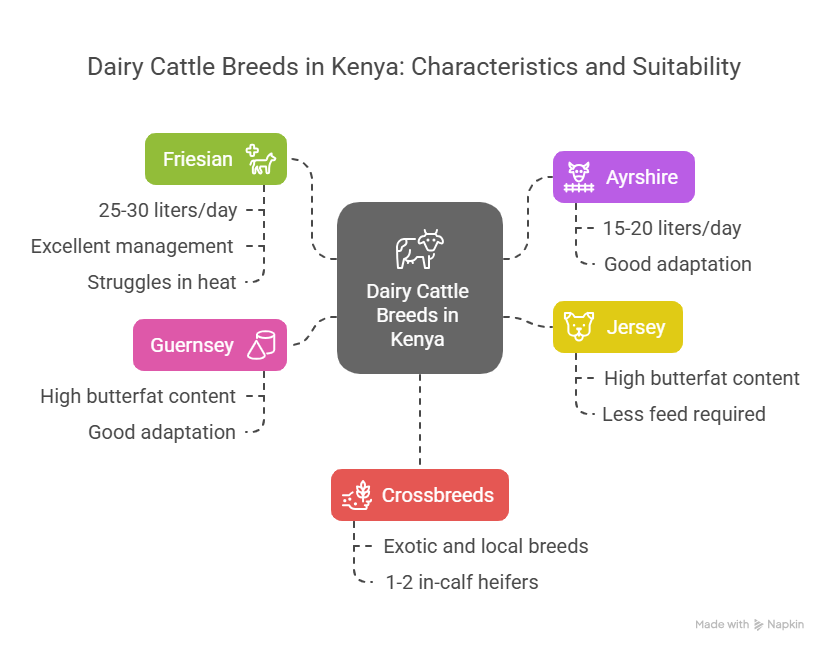
Step 4: Housing and Infrastructure Setup
Proper housing isn’t just about comfort—it directly affects your cows’ health and productivity.
Zero-Grazing Units
For beginners with limited land, zero-grazing systems offer an efficient approach. This involves keeping cattle confined and bringing feed to them rather than letting them graze freely. Benefits include:
- Maximized land use efficiency
- Better control over feeding
- Easier manure collection for fertilizer or biogas
- Reduced spread of diseases and parasites
Essential Features of a Good Cow Shed
Your cow shed should include:
- Roof: Waterproof roofing that provides adequate shade
- Floor: Slightly sloped, non-slip concrete for easy cleaning and drainage
- Feeding area: Raised feeding troughs to prevent contamination
- Water troughs: Clean, easily accessible water supply
- Bedding area: Comfortable, dry bedding material like sawdust or straw
- Proper ventilation: Good airflow without direct drafts
- Calf pens: Separate area for calves
Milking Area Requirements
Set up a dedicated milking area that’s:
- Easy to clean and disinfect
- Well-lit for proper inspection of milk
- Protected from dust and contamination
- Equipped with handwashing facilities
Storage Facilities
You’ll need storage for:
- Feed and supplements
- Milk (if you plan to store before delivery)
- Equipment and tools
- Veterinary supplies
Step 5: Feeding Systems and Nutrition Management
Feed costs can make up a staggering 84.8% of your total farm operating expenses, so getting your feeding strategy right is crucial for profitability.
Balanced Diet Components
Your cows need:
- Roughage/Forage: The foundation of their diet
- Napier grass, Rhodes grass, or other local grasses
- Hay for dry season feeding
- Silage for long-term storage
- Concentrates: To boost nutrition and production
- Dairy meal (commercial or homemade)
- Protein sources like cottonseed cake or sunflower meal
- Energy sources like maize bran or wheat bran
- Minerals and supplements: Essential for health and production
- Mineral licks or powders
- Salt blocks
- Vitamin supplements when necessary
Forage Production and Conservation
To reduce feed costs:
- Grow your own Napier grass or fodder crops
- Make silage during the rainy season to use during dry periods
- Consider hydroponics for year-round green fodder production
Water Requirements
Dairy cows need 40-80 liters of clean water daily, depending on their production level, size, and the weather. Implement daily monitoring of water sources and consider rainwater harvesting systems to ensure consistent access.
Modern Nutrition Innovations
To boost productivity:
- Consider using probiotics and prebiotics in cattle feed to support gut health
- Improve digestion and nutrient absorption
- Enhance milk yield and quality
This table summarizes daily feed requirements for a typical dairy cow in Kenya:
| Feed Type | Amount per Day | Purpose |
|---|---|---|
| Napier grass/Forage | 40-60 kg (fresh weight) | Primary energy source |
| Dairy meal | 2-8 kg (based on production) | Production support |
| Mineral supplements | 100-150 g | Health maintenance |
| Clean water | 40-80 liters | Hydration & milk production |
Step 6: Health Management and Breeding
Essential Vaccinations and Disease Prevention
Preventative healthcare saves money in the long run. Implement a vaccination program that includes:
- East Coast Fever (ECF)
- Foot and Mouth Disease
- Anthrax
- Lumpy Skin Disease
- Brucellosis
Regular Health Checks
Establish a relationship with a local veterinarian for:
- Monthly health checks
- Prompt treatment of any illnesses
- Parasite control programs
- Mastitis prevention and treatment
Breeding Options
You have two main breeding approaches:
- Artificial Insemination (AI)
- More affordable than keeping a bull
- Access to superior genetics
- Can take advantage of government-subsidized semen programs
- Requires timing and access to AI services
- Bull Service
- May be more reliable in areas with poor AI access
- Higher upfront cost if purchasing your own bull
- Eliminates timing issues
- Requires additional housing and feeding
Calving and Calf Management
Proper calf raising ensures the future of your herd:
- Ensure calves get colostrum within 6 hours of birth
- Implement proper dehorning and identification
- Follow a strategic weaning program
- Maintain proper nutrition for growth
- Monitor for common calf diseases
Step 7: Milking Practices and Quality Control
Milking Equipment
For beginners, hand milking is usually sufficient. You’ll need:
- Clean milking buckets (aluminum or stainless steel)
- Teat dip cups and solution
- Milk filters
- Storage containers (if not delivering immediately)
- Cleaning supplies
Proper Milking Procedure
Follow these steps for clean, high-quality milk:
- Clean the udder with warm water
- Dry with a clean cloth
- Apply pre-milking teat dip and wipe dry
- Check for abnormal milk using a strip cup
- Milk quickly and completely (5-7 minutes per cow)
- Apply post-milking teat dip
- Filter milk immediately
- Cool milk quickly if not delivering immediately
Milk Handling and Storage
Without proper cooling facilities:
- Deliver milk to collection centers within 2 hours of milking
- Keep milk in shade if immediate delivery isn’t possible
- Use insulated containers
With cooling facilities:
- Cool milk to 4°C within 2 hours of milking
- Store in food-grade containers
- Maintain cooling chain until delivery
Step 8: Waste Management and Sustainable Practices
Smart waste management can turn a potential problem into a profit center.
Manure Handling
Implement a regular cleaning protocol for animal housing to:
- Minimize waste buildup
- Reduce odors
- Prevent disease spread
- Collect valuable fertilizer
Biogas Production
Consider installing a biogas digester to:
- Convert cow dung into cooking gas
- Produce nutrient-rich slurry for crops
- Reduce environmental impact
- Lower energy costs
Composting Systems
Establish a composting system to:
- Transform daily waste into valuable soil amendments
- Reduce environmental pollution
- Create additional farm income through compost sales
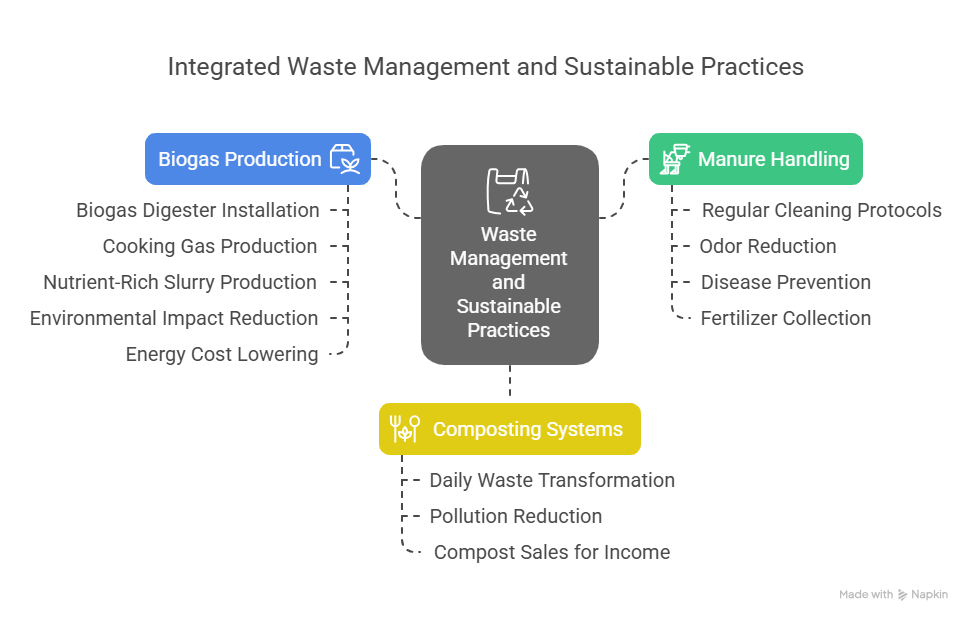
Step 9: Record Keeping and Financial Management
Essential Records to Maintain
Keep detailed records of:
- Milk production (daily, per cow)
- Feed consumption and costs
- Health treatments and vaccinations
- Breeding and calving dates
- Income and expenses
- Animal inventory
Financial Planning
Understand the economics of dairy farming:
- Initial investment costs (land, animals, infrastructure)
- Operating costs (feed, labor, veterinary care)
- Revenue projections based on current milk prices
- Cash flow management for seasonal variations
As noted in a Kenya Dairy Board study, dairy operations can face losses of up to 16% without proper management. Plan your finances carefully to avoid this outcome.
Sample Budget Breakdown
| Expense Category | Percentage of Operating Costs | Notes |
|---|---|---|
| Feed costs | 84.8% | Largest expense by far |
| Labor | 6.2% | Second highest expense |
| Breeding costs | 2.6% | Includes AI services |
| Other costs | 6.4% | Veterinary, transport, etc. |
Step 10: Marketing and Sales Strategies
Choosing Your Market Channel
You have several options:
- Direct consumer sales
- Higher margins but limited volume
- Requires compliance with raw milk regulations
- Builds direct customer relationships
- Dairy cooperatives
- Consistent market access
- Additional support services
- Sometimes lower prices but guaranteed sales
- Milk processors
- More stable pricing through formal contracts
- Higher quality requirements
- Potential for premium payments for quality
- Value-added products
- Yogurt, cheese, or butter production
- Higher margins but requires additional skills and equipment
- Diversifies income streams
Price Negotiation
Know that Kenya introduced a Guaranteed Minimum Returns scheme in 2021, establishing fixed minimum prices for milk sold to aggregators and direct sales. Understand these minimums before negotiating prices.
Building Customer Loyalty
- Consistently deliver high-quality milk
- Maintain reliable supply schedules
- Build relationships with buyers
- Consider branding if selling direct to consumers
Conclusion: Your Dairy Farming Journey
Starting a dairy farm in Kenya is both challenging and rewarding. The sector faces significant hurdles—from high feed costs to climate challenges—but also offers substantial opportunities for those willing to adopt modern practices and embrace sustainability.
Remember that Kenya’s dairy industry is in transition. Government initiatives through the New KCC aim to increase farm-gate prices and expand processing capacity. Meanwhile, innovations in sustainable farming practices, including zero-grazing systems, biogas generation, and improved animal nutrition, offer paths to better environmental and economic outcomes.
Start small, learn continuously, and scale gradually. Connect with other farmers, join cooperatives, and take advantage of training offered by the Kenya Dairy Board and research organizations. With commitment and smart management, your dairy farm can become a sustainable source of income while contributing to Kenya’s food security and economic development.
Ready to get your hands dirty? Your dairy farming journey starts now.




